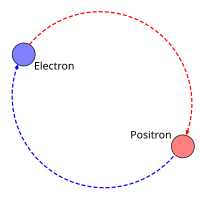Positronium

Positronium is a word made up of two parts: positron and ium. A positron is like an anti-electron, meaning it has the same amount of energy as an electron but the opposite charge. An ium is a suffix used in chemistry to indicate a material, like how sodium becomes sodium-ium in sodium chloride.
Think of it like this: Imagine playing with two magnets. When you try to push them together the wrong way, they repel each other because they both have the same magnetic charge. Electrons and positrons behave the same way. However, if you can get them to come into contact, they can create something similar to a magnet called a "bond" where they are attracted to each other.
This is what happens with positronium. A positron and an electron come together and form a pair, like a dance partner, for a brief moment before they "annihilate" or disappear. During this brief time, they can form a bond called a "bound state."
People who study positronium have found that these bonds can last longer if the electrons and positrons are in a vacuum or if they are separated by a substance that doesn't interact much with them, like helium gas.
Scientists use positronium to help them understand how particles work and how to use them in new ways. They study things like how long the bonds last and how they behave in different environments. All of this helps us learn more about the world around us.
Think of it like this: Imagine playing with two magnets. When you try to push them together the wrong way, they repel each other because they both have the same magnetic charge. Electrons and positrons behave the same way. However, if you can get them to come into contact, they can create something similar to a magnet called a "bond" where they are attracted to each other.
This is what happens with positronium. A positron and an electron come together and form a pair, like a dance partner, for a brief moment before they "annihilate" or disappear. During this brief time, they can form a bond called a "bound state."
People who study positronium have found that these bonds can last longer if the electrons and positrons are in a vacuum or if they are separated by a substance that doesn't interact much with them, like helium gas.
Scientists use positronium to help them understand how particles work and how to use them in new ways. They study things like how long the bonds last and how they behave in different environments. All of this helps us learn more about the world around us.
Related topics others have asked about:
